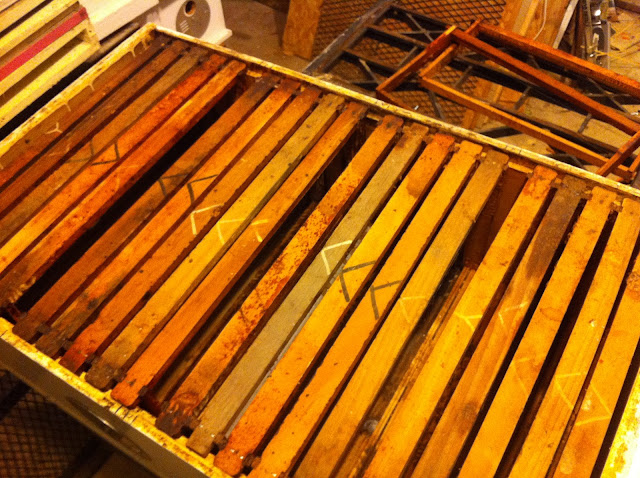I recently ordered an Oshlun stack dado blade.
What you're looking at is 124 (+/-) teeth of fury! I'm going to use it to cut frame rests and rabbets for hive boxes as well as use it to cut dadoes for dividers in queen castles and nucs. This is a pretty good quality dado blade and makes good quality stuff. The cutters have 44 teeth and the chippers have six teeth each. This makes for a very heavy set and the motor takes about five whole seconds to spin it up. But it works fantastically, and I'm going to use it a lot as I'm building my new legion of medium boxes.
Here you can see my design for a 4x5 nuc, that's four five frame nucs in one box. The last thing to add is the dividers.
I did a test run with the dado blade and made some ends for a 6 frame nuc. All I need to do is cut the sides and make a bottom and lid and it will be ready to go. Now that I think about it, it would make a perfect example for my first six frame medium nuc, possibly to overwinter.
Finally, here is evidence that given the opportunity, bees will size the entrance how they want it.
This is a hive in my outyard where the bees reduced the entrance even further than I had reduced it. As you can see, they still didn't close it all the way off. For context, this hive has a 1 1/2" round entrance near the bottom.
Another hive on this pallet seems to me to be burning too brightly. By that I mean they are too big and using their stores too fast. I hope they can slow it down and last the winter. On the other hand, they are a bit mean, and with that in mind, I doubt I would breed from them.
What you're looking at is 124 (+/-) teeth of fury! I'm going to use it to cut frame rests and rabbets for hive boxes as well as use it to cut dadoes for dividers in queen castles and nucs. This is a pretty good quality dado blade and makes good quality stuff. The cutters have 44 teeth and the chippers have six teeth each. This makes for a very heavy set and the motor takes about five whole seconds to spin it up. But it works fantastically, and I'm going to use it a lot as I'm building my new legion of medium boxes.
Here you can see my design for a 4x5 nuc, that's four five frame nucs in one box. The last thing to add is the dividers.
I did a test run with the dado blade and made some ends for a 6 frame nuc. All I need to do is cut the sides and make a bottom and lid and it will be ready to go. Now that I think about it, it would make a perfect example for my first six frame medium nuc, possibly to overwinter.
Finally, here is evidence that given the opportunity, bees will size the entrance how they want it.
This is a hive in my outyard where the bees reduced the entrance even further than I had reduced it. As you can see, they still didn't close it all the way off. For context, this hive has a 1 1/2" round entrance near the bottom.
Another hive on this pallet seems to me to be burning too brightly. By that I mean they are too big and using their stores too fast. I hope they can slow it down and last the winter. On the other hand, they are a bit mean, and with that in mind, I doubt I would breed from them.








